Development of Low-Frequency Phased Array for Imaging Defects in Concrete Structures
Abstract
:1. Introduction
2. Development of LF Array Transducer
3. Experiments of Imaging Concrete Specimens
3.1. Concrete Specimen with a Delamination
3.2. Concrete Specimen with Crack-Type Defect (i.e., a Slit)
4. Discussion
5. Conclusions
Author Contributions
Funding
Institutional Review Board Statement
Informed Consent Statement
Data Availability Statement
Acknowledgments
Conflicts of Interest
References
- Fujii, H.; Yamashita, A.; Asama, H. Automated diagnosis of material condition in hammering test using a boosting algorithm. In Proceedings of the 2014 IEEE International Workshop on Advanced Robotics and its Social Impacts, Evanston, IL, USA, 11–13 September 2014; Volume 80, pp. 101–107. [Google Scholar]
- Schubert, F.; Köhler, B. Ten lectures on impact-echo. J. Nondestruct. Eval. 2008, 27, 5–21. [Google Scholar] [CrossRef]
- Blitz, J.; Simpson, G. Ultrasonic Methods of Non-Destructive Testing; Springer: Berlin/Heidelberg, Germany, 1995. [Google Scholar]
- Karaiskos, G.; Deraemaeker, A.; Aggelis, D.G.; Van Hemelrijck, D. Monitoring of concrete structures using the ultrasonic pulse velocity method. Smart Mater. Struct. 2015, 24, 113001. [Google Scholar] [CrossRef] [Green Version]
- Drinkwater, B.W.; Wilcox, P.D. Ultrasonic arrays for non-destructive evaluation: A review. NDT E Int. 2006, 39, 525–541. [Google Scholar] [CrossRef]
- Schmerr, L.W. Fundamentals of Ultrasonic Phased Arrays; Solid Mechanics and Its Applications; Springer International Publishing: Cham, Germany, 2015; Volume 215, ISBN 978-3-319-07271-5. [Google Scholar]
- Szabo, T.L. Diagnostic Ultrasound Imaging: Inside out: Second Edition; Academic Press: Oxford, UK, 2004; ISBN 9780123964878. [Google Scholar]
- Ohara, Y.; Mihara, T.; Sasaki, R.; Ogata, T.; Yamamoto, S.; Kishimoto, Y.; Yamanaka, K. Imaging of closed cracks using nonlinear response of elastic waves at subharmonic frequency. Appl. Phys. Lett. 2007, 90, 011902. [Google Scholar] [CrossRef]
- Ohara, Y.; Takahashi, K.; Murai, S.; Yamanaka, K. High-selectivity imaging of closed cracks using elastic waves with thermal stress induced by global preheating and local cooling. Appl. Phys. Lett. 2013, 103, 031917. [Google Scholar] [CrossRef]
- Takahashi, K.; Jinno, K.; Ohara, Y.; Yamanaka, K. Evaluation of crack closure stress by analyses of ultrasonic phased array images during global preheating and local cooling. Jpn. J. Appl. Phys. 2014, 53, 07KC20. [Google Scholar] [CrossRef]
- Jinno, K.; Sugawara, A.; Ohara, Y.; Yamanaka, K. Analysis on nonlinear ultrasonic images of vertical closed cracks by damped double node model. Mater. Trans. 2014, 55, 1017–1023. [Google Scholar] [CrossRef] [Green Version]
- Potter, J.N.; Croxford, A.J.; Wilcox, P.D. Nonlinear ultrasonic phased array imaging. Phys. Rev. Lett. 2014, 113, 144301. [Google Scholar] [CrossRef] [Green Version]
- Ohara, Y.; Takahashi, K.; Ino, Y.; Yamanaka, K.; Tsuji, T.; Mihara, T. High-selectivity imaging of closed cracks in a coarse-grained stainless steel by nonlinear ultrasonic phased array. NDT E Int. 2017, 91, 139–147. [Google Scholar] [CrossRef]
- Ohara, Y.; Takahashi, K.; Jinno, K.; Yamanaka, K. High-selectivity ultrasonic imaging of closed cracks using global preheating and local cooling. Mater. Trans. 2014, 55, 1003–1010. [Google Scholar] [CrossRef] [Green Version]
- Hoegh, K.; Khazanovich, L.; Maser, K.; Tran, N. Evaluation of ultrasonic technique for detecting delamination in Asphalt pavements. Transp. Res. Rec. J. Transp. Res. Board 2012, 2306, 105–110. [Google Scholar] [CrossRef] [Green Version]
- Shokouhi, P.; Wolf, J.; Wiggenhauser, H. Detection of delamination in concrete bridge decks by joint amplitude and phase analysis of ultrasonic array measurements. J. Bridg. Eng. 2014, 19, 04013005. [Google Scholar] [CrossRef]
- Lin, S.; Shams, S.; Choi, H.; Azari, H. Ultrasonic imaging of multi-layer concrete structures. NDT E Int. 2018, 98, 101–109. [Google Scholar] [CrossRef]
- Domínguez, I.S.; Contla, P.A.; Hernández, E.M.; von Krüger, M.A. Crosstalk effects caused by the geometry of piezoelectric elements in matrix ultrasonic transducers. Braz. J. Biomed. Eng. 2011, 27, 90–97. [Google Scholar] [CrossRef] [Green Version]
- Bybi, A.; Grondel, S.; Assaad, J.; Hladky-Hennion, A.C.; Granger, C.; Rguiti, M. Reducing crosstalk in array structures by controlling the excitation voltage of individual elements: A feasibility study. Ultrasonics 2013, 53, 1135–1140. [Google Scholar] [CrossRef] [PubMed]
- Toda, M.; Thompson, M. Novel multi-layer polymer-metal structures for use in ultrasonic transducer impedance matching and backing absorber applications. IEEE Trans. Ultrason. Ferroelectr. Freq. Control 2010, 57, 2818–2827. [Google Scholar] [CrossRef] [PubMed]
- Nguyen, N.T.; Lethiecq, M.; Karlsson, B.; Patat, F. Highly attenuative rubber modified epoxy for ultrasonic transducer backing applications. Ultrasonics 1996, 34, 669–675. [Google Scholar] [CrossRef]
- Ji, S.M.; Sung, J.H.; Park, C.Y.; Jeong, J.S. Phase-canceled backing structure for lightweight ultrasonic transducer. Sens. Actuators A Phys. 2017, 260, 161–168. [Google Scholar] [CrossRef]
- Mihara, T.; Hamajima, T.; Tashiro, H.; Sato, A. Ultrasonic inspection of rocket fuel model using laminated transducer and multi-channel step pulser. AIP Conf. Proc. 2013, 1511, 1617–1622. [Google Scholar] [CrossRef]
- Mihara, T.; Konishi, G.; Miura, Y.; Ishida, H. Accurate sizing of closed crack using nonlinear ultrasound of SPACE with high voltage transformer pulser technique. AIP Conf. Proc. 2014, 1581, 727. [Google Scholar] [CrossRef]
- Kim, J.N.; Liu, T.; Jackson, T.N.; Choi, K.; Trolier-Mckinstry, S.; Tutwiler, R.L.; Todd, J.A. 10 MHz thin-film PZT-based flexible PMUT array: Finite element design and characterization. Sensors 2020, 20, 4335. [Google Scholar] [CrossRef] [PubMed]
- Lin, P.; Zhang, L.; Fei, C.; Li, D.; Wu, R.; Chen, Q.; Hou, C.; Yang, Y. Novel multi-layer-composites design for ultrasonic transducer applications. Compos. Struct. 2020, 245, 112364. [Google Scholar] [CrossRef]
- Zhu, J.; Popovics, J.S. Imaging concrete structures using air-coupled impact-echo. J. Eng. Mech. 2007, 133, 628–640. [Google Scholar] [CrossRef]
- Petro, J.T.; Kim, J. Detection of delamination in concrete using ultrasonic pulse velocity test. Constr. Build. Mater. 2012, 26, 574–582. [Google Scholar] [CrossRef]
- Wong, C.M.; Chen, Y.; Luo, H.; Dai, J.; Lam, K.H.; Chan, H.L. Development of a 20-MHz wide-bandwidth PMN-PT single crystal phased-array ultrasound transducer. Ultrasonics 2017, 73, 181–186. [Google Scholar] [CrossRef]
- Park, C.Y.; Sung, J.H.; Jeong, J.S. Design and fabrication of ultrasound linear array transducer based on polarization inversion technique. Sens. Actuators A Phys. 2018, 280, 484–494. [Google Scholar] [CrossRef]
- Dupont-Marillia, F.; Jahazi, M.; Lafreniere, S.; Belanger, P. Design and optimisation of a phased array transducer for ultrasonic inspection of large forged steel ingots. NDT E Int. 2019, 103, 119–129. [Google Scholar] [CrossRef]
- Kim, G.; Seo, M.K.; Kim, Y.I.; Kwon, S.; Kim, K.B. Development of phased array ultrasonic system for detecting rail cracks. Sens. Actuators A Phys. 2020, 311, 112086. [Google Scholar] [CrossRef]
- Ouchi, A.; Sugawara, A.; Ohara, Y.; Yamanaka, K. Subharmonic phased array for crack evaluation using surface acoustic wave. Jpn. J. Appl. Phys. 2015, 54, 07HC05. [Google Scholar] [CrossRef]
- Ohara, Y.; Oshiumi, T.; Nakajima, H.; Yamanaka, K.; Wu, X.; Uchimoto, T.; Takagi, T.; Tsuji, T.; Mihara, T. Ultrasonic phased array with surface acoustic wave for imaging cracks. AIP Adv. 2017, 7, 065214. [Google Scholar] [CrossRef] [Green Version]
- Ohara, Y.; Nakajima, H.; Tsuji, T.; Mihara, T. Nonlinear surface-acoustic-wave phased array with fixed-voltage fundamental wave amplitude difference for imaging closed cracks. NDT E Int. 2019, 108, 102170. [Google Scholar] [CrossRef]
- Ohara, Y.; Potter, J.; Nakajima, H.; Tsuji, T.; Mihara, T. Multi-mode nonlinear ultrasonic phased array for imaging closed cracks. Jpn. J. Appl. Phys. 2019, 58, SGGB06. [Google Scholar] [CrossRef]
- Pörtzgen, N.; Gisolf, D.; Blacquière, G. Inverse wave field extrapolation: A different NDI approach to imaging defects. IEEE Trans. Ultrason. Ferroelectr. Freq. Control 2007, 54, 118–127. [Google Scholar] [CrossRef] [PubMed]
- Pörtzgen, N.; Gisolf, D.; Verschuur, D.J. Wave equation-based imaging of mode converted waves in ultrasonic NDI, with suppressed leakage from nonmode converted waves. IEEE Trans. Ultrason. Ferroelectr. Freq. Control 2008, 55, 1768–1780. [Google Scholar] [CrossRef]
- Le Jeune, L.; Robert, S.; Lopez Villaverde, E.; Prada, C. Plane wave imaging for ultrasonic non-destructive testing: Generalization to multimodal imaging. Ultrasonics 2016, 64, 128–138. [Google Scholar] [CrossRef] [PubMed] [Green Version]
- Beniwal, S.; Ghosh, D.; Ganguli, A. Ultrasonic imaging of concrete using scattered elastic wave modes. NDT E Int. 2016, 82, 26–35. [Google Scholar] [CrossRef]
- Hamidi, S.; ShahbazPanahi, S. Sparse signal recovery based imaging in the presence of mode conversion with application to non-destructive testing. IEEE Trans. Signal Process. 2016, 64, 1352–1364. [Google Scholar] [CrossRef]
- Versaci, M.; Angiulli, G.; Di Barba, P.; Morabito, F.C. Joint use of eddy current imaging and fuzzy similarities to assess the integrity of steel plates. Open Phys. 2020, 18, 230–240. [Google Scholar] [CrossRef]
- Goodman, J.W. Introduction to Fourier Optics, 3rd ed.; Roberts and Company Publishers: Englewood, NJ, USA, 2004; ISBN 0974707724. [Google Scholar]
- Wooh, S.; Shi, Y. Influence of phased array element size on beam steering behavior. Ultrasonics 1998, 36, 737–749. [Google Scholar] [CrossRef]
- Ohara, Y.; Remillieux, M.C.; Onuma, T.; Tsunoda, K.; Tsuji, T.; Mihara, T. Toward an ultra-high resolution phased-array system for 3D ultrasonic imaging of solids. Appl. Phys. Lett. 2020, 117, 111902. [Google Scholar] [CrossRef]
- Rabut, C.; Correia, M.; Finel, V.; Pezet, S.; Pernot, M.; Deffieux, T.; Tanter, M. 4D functional ultrasound imaging of whole-brain activity in rodents. Nat. Methods 2019, 16, 994–997. [Google Scholar] [CrossRef]
- Prada, C.; Manneville, S.; Spoliansky, D.; Fink, M. Decomposition of the time reversal operator: Detection and selective focusing on two scatterers. J. Acoust. Soc. Am. 1996, 99, 2067–2076. [Google Scholar] [CrossRef]
- Prada, C.; Thomas, J.-L. Experimental subwavelength localization of scatterers by decomposition of the time reversal operator interpreted as a covariance matrix. J. Acoust. Soc. Am. 2003, 114, 235–243. [Google Scholar] [CrossRef] [PubMed] [Green Version]
- Marengo, E.A.; Gruber, F.K.; Simonetti, F. Time-reversal MUSIC imaging of extended targets. IEEE Trans. Image Process. 2007, 16, 1967–1984. [Google Scholar] [CrossRef]
- Kirsch, A. The MUSIC algorithm and the factorization method in inverse scattering theory for inhomogeneous media. Inverse Probl. 2002, 18, 1025–1040. [Google Scholar] [CrossRef]
- Seidl, R.; Rank, E. Iterative time reversal based flaw identification. Comput. Math. Appl. 2016, 72, 879–892. [Google Scholar] [CrossRef]
- Fan, C.; Pan, M.; Luo, F.; Drinkwater, B. Multi-frequency time-reversal-based imaging for ultrasonic nondestructive evaluation using full matrix capture. IEEE Trans. Ultrason. Ferroelectr. Freq. Control 2014, 61, 2067–2074. [Google Scholar] [CrossRef] [PubMed]

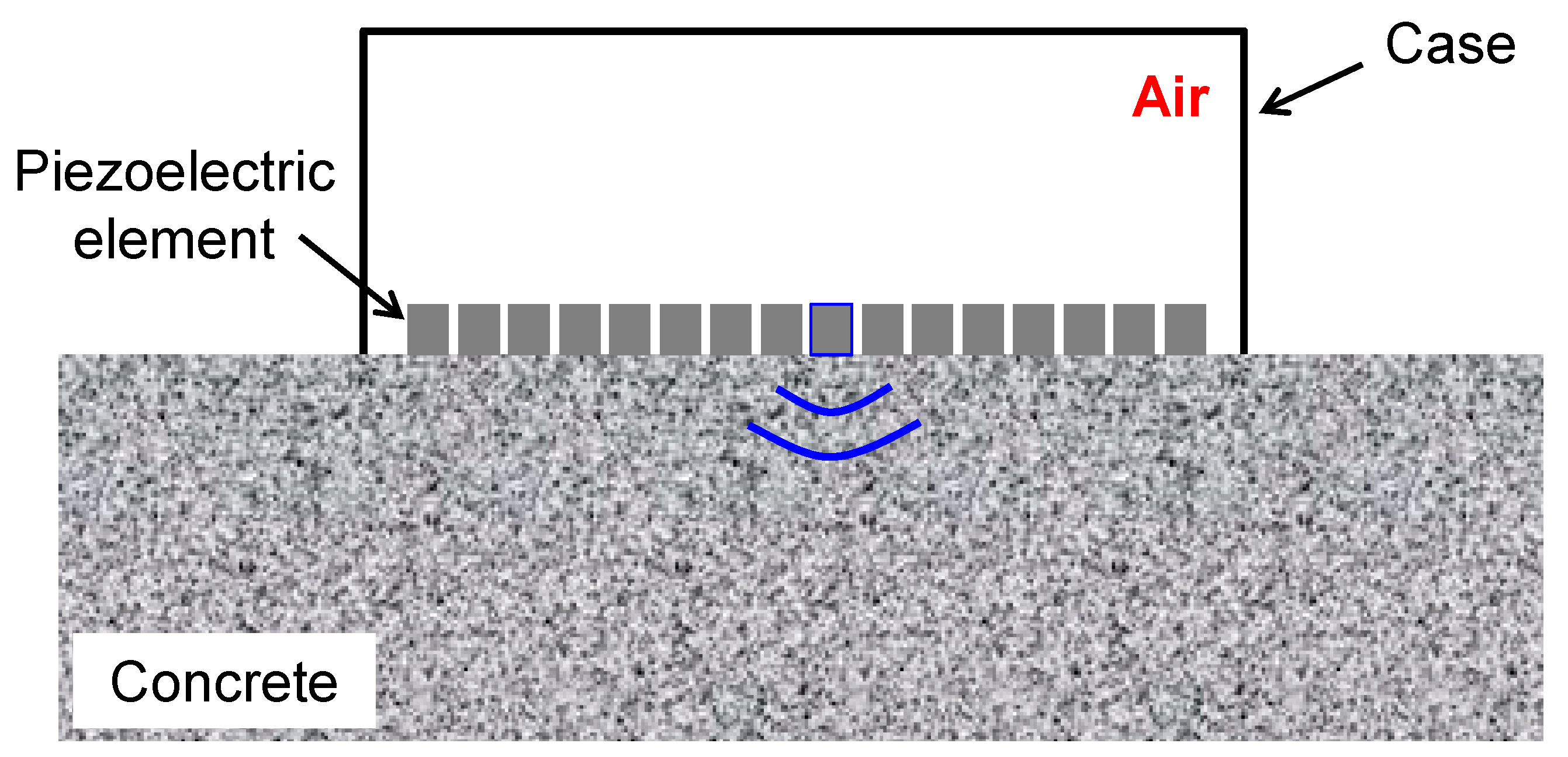
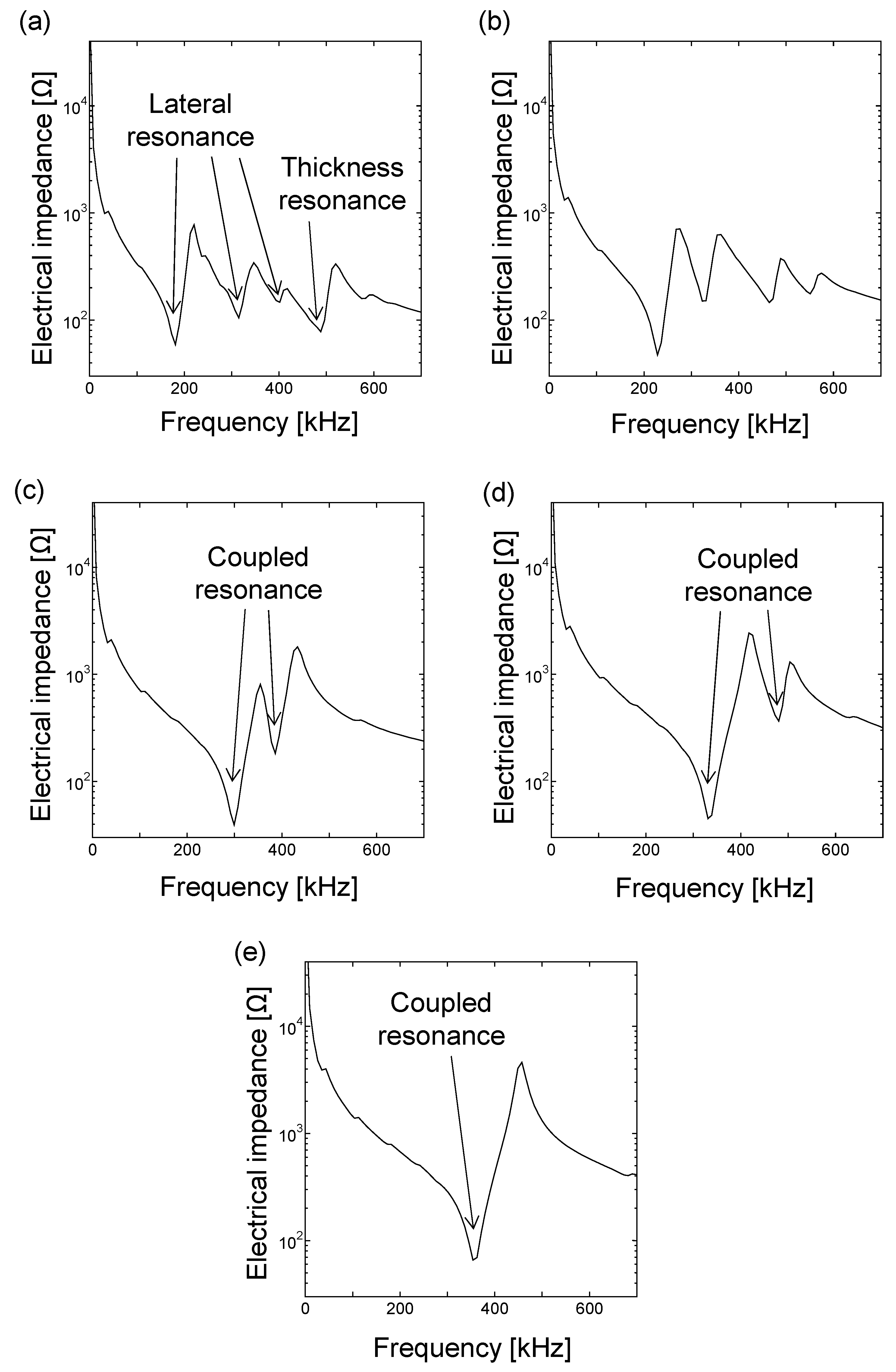
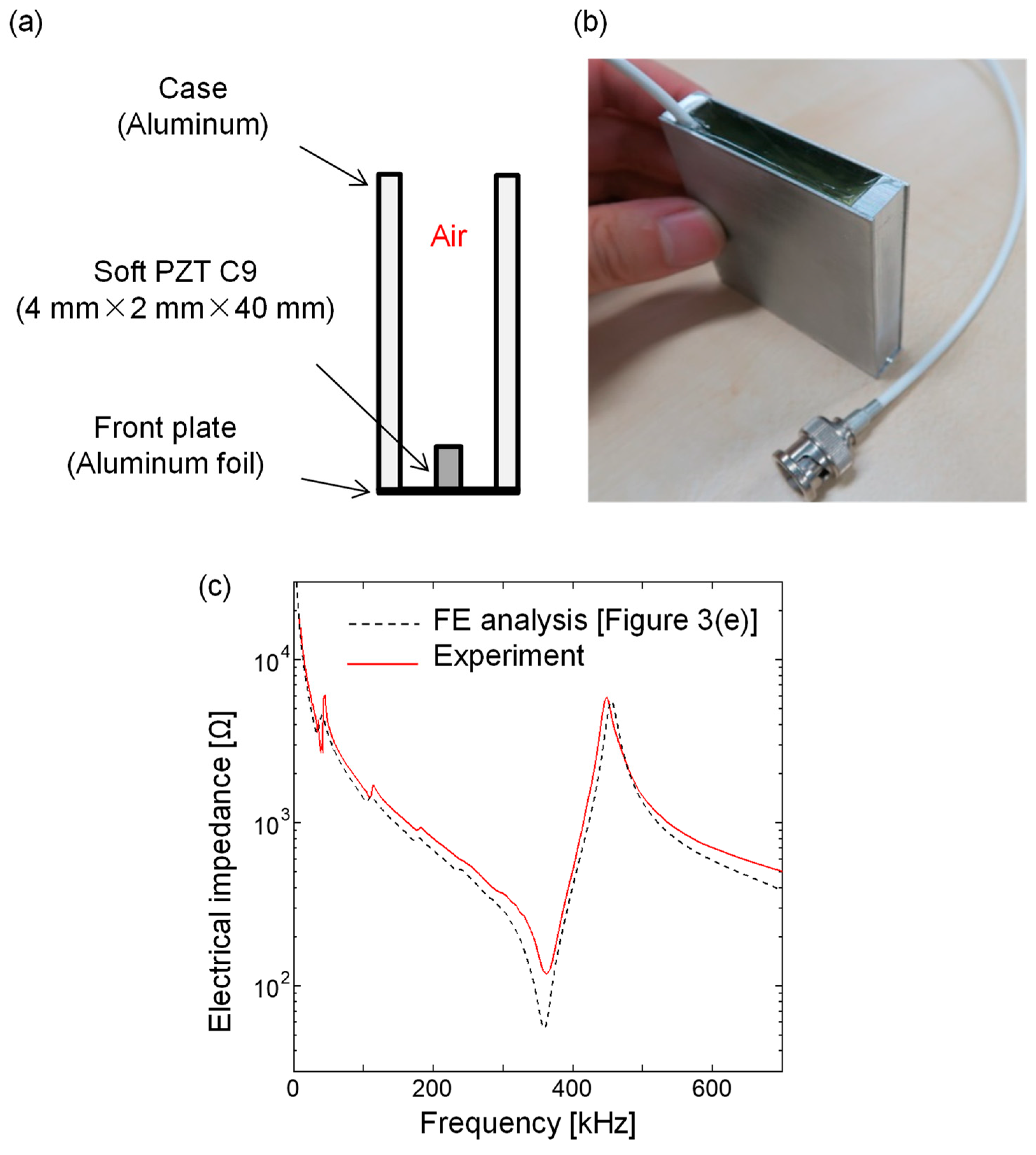
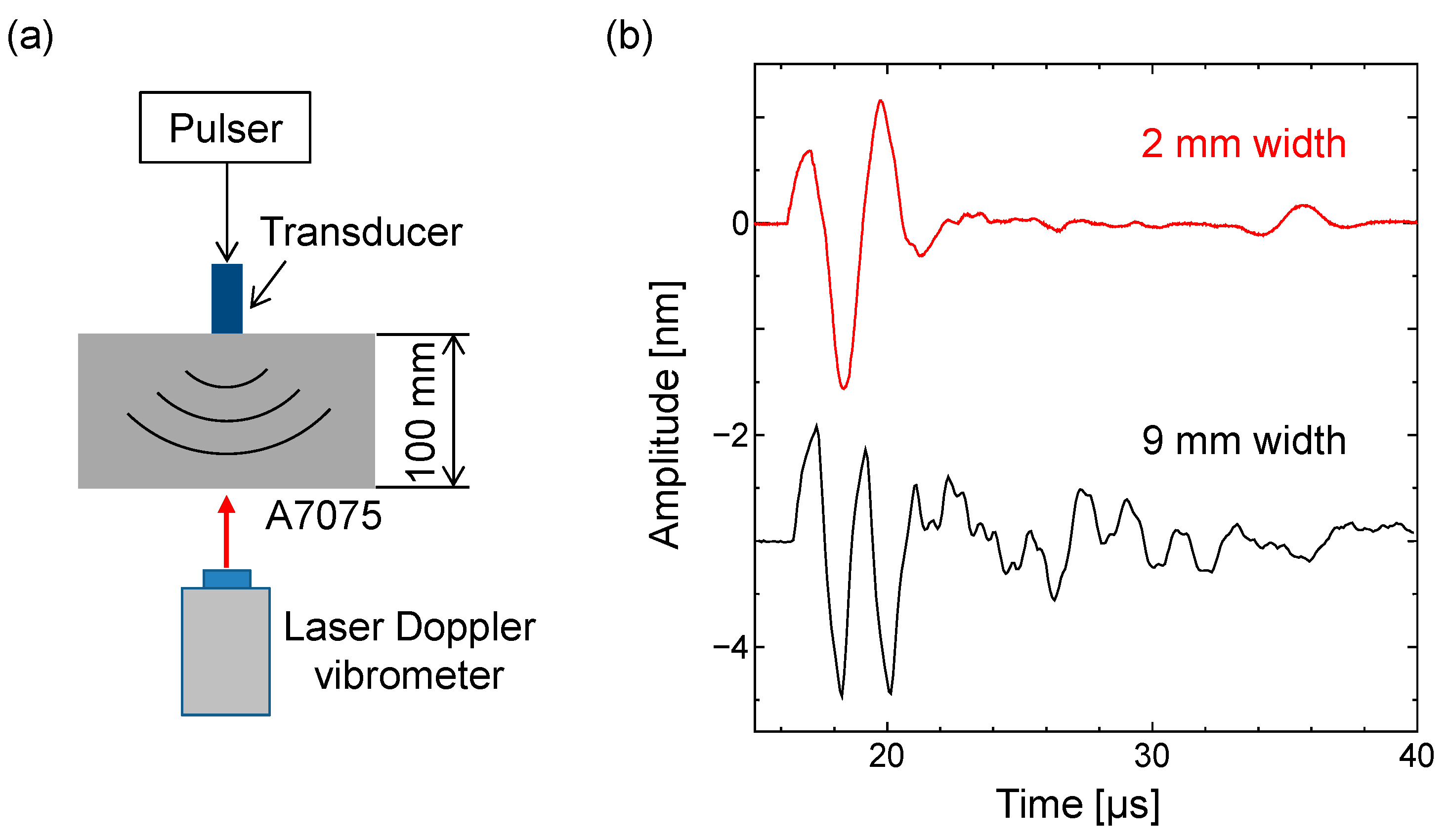
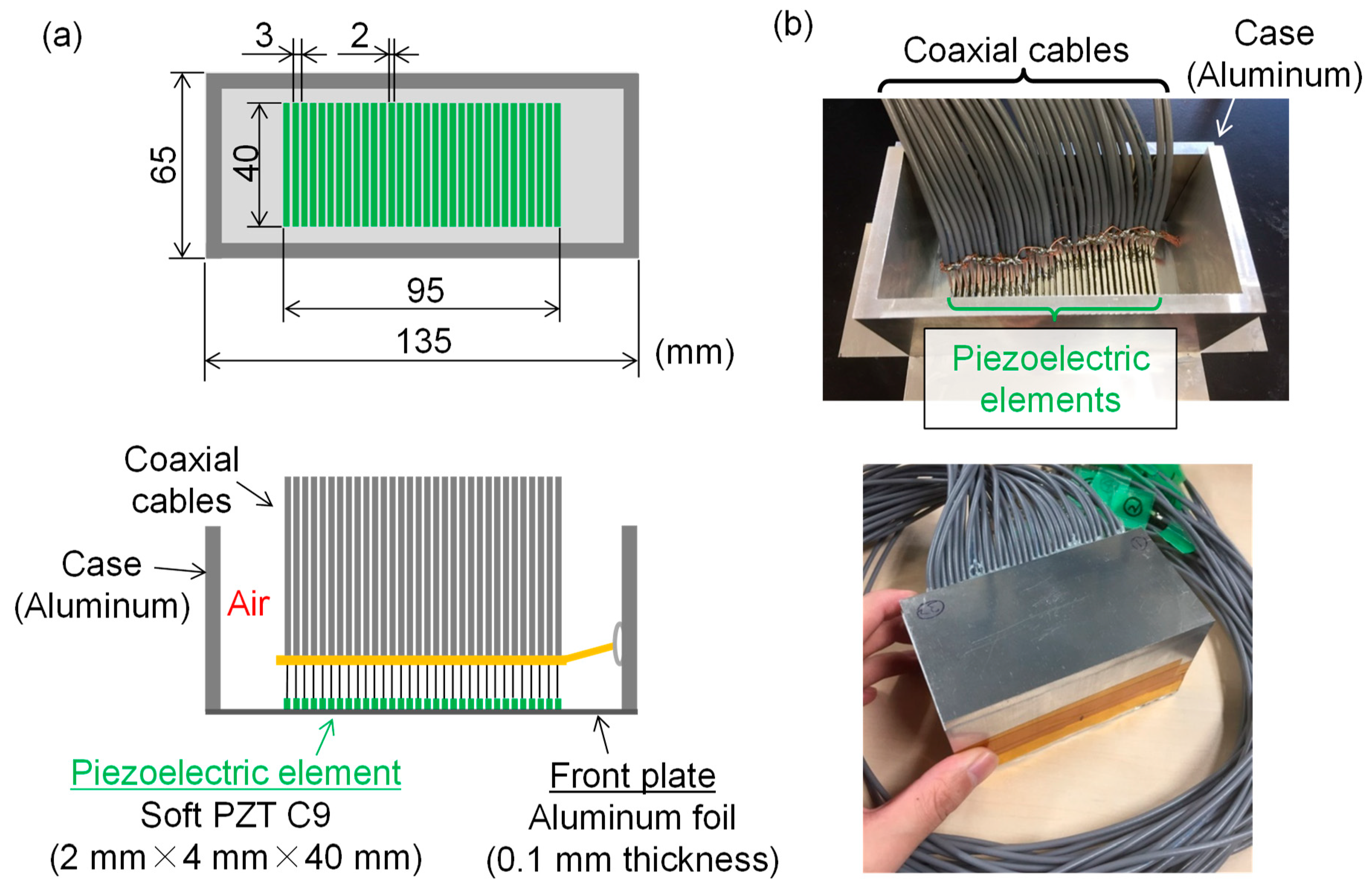
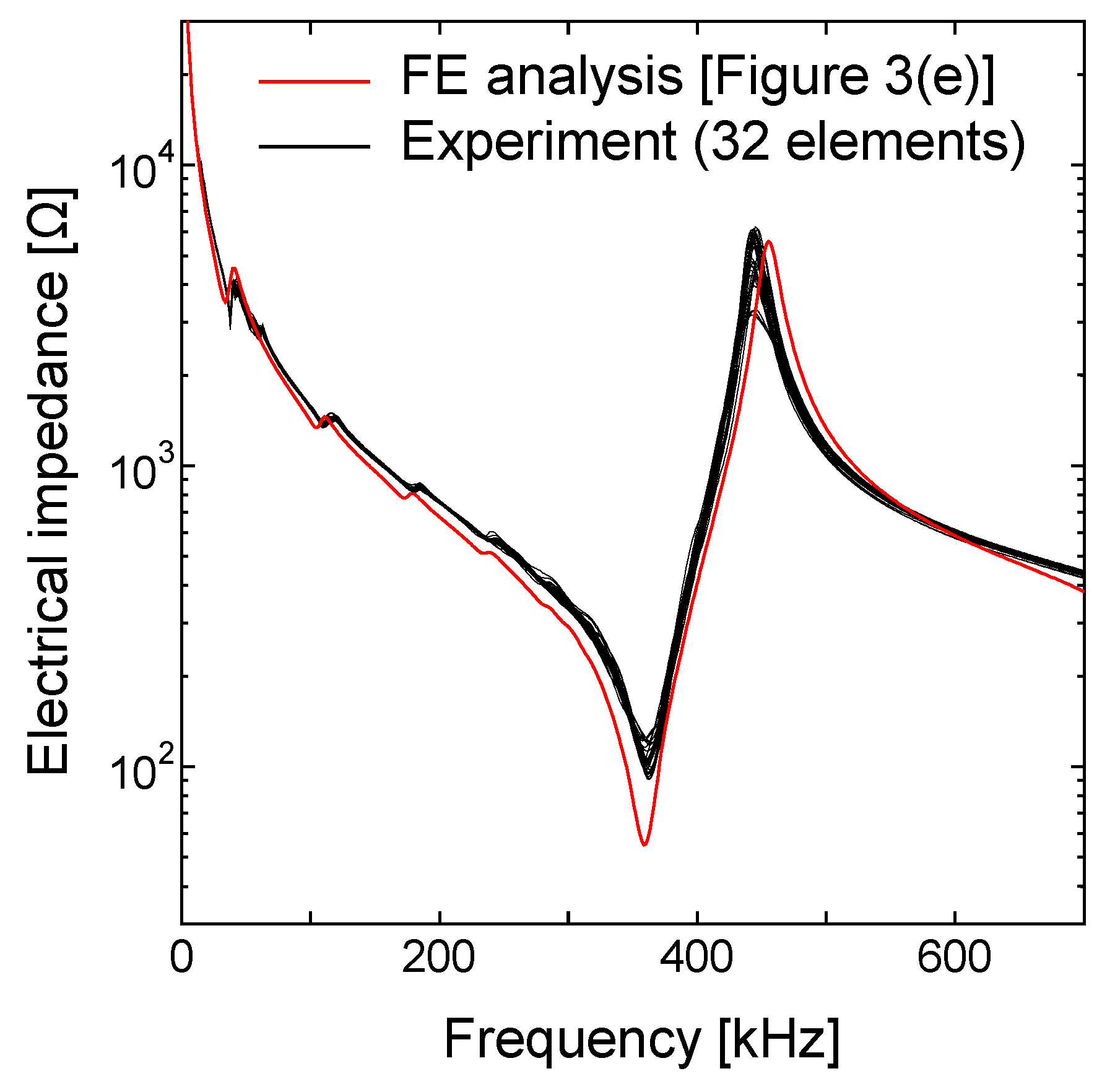


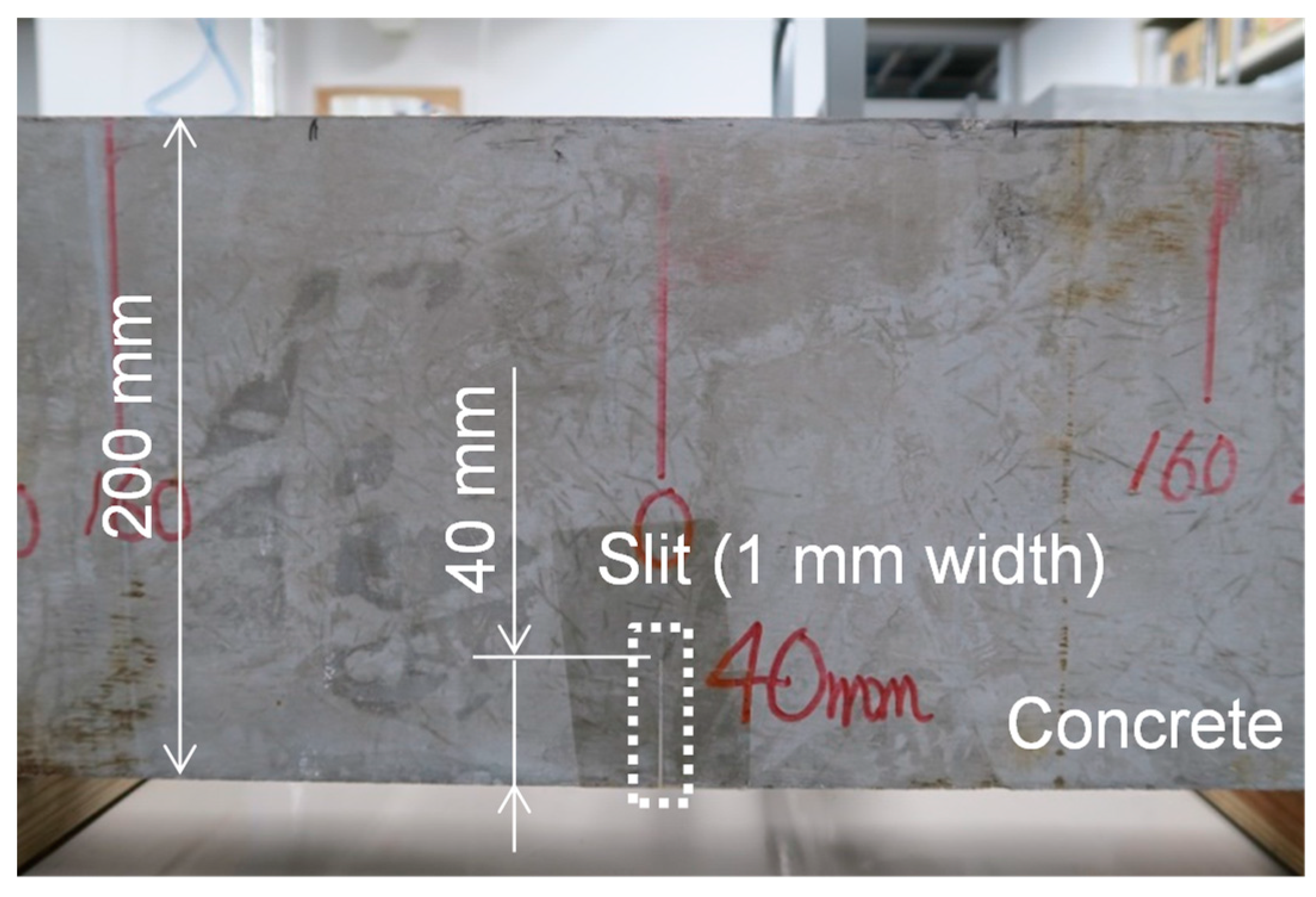
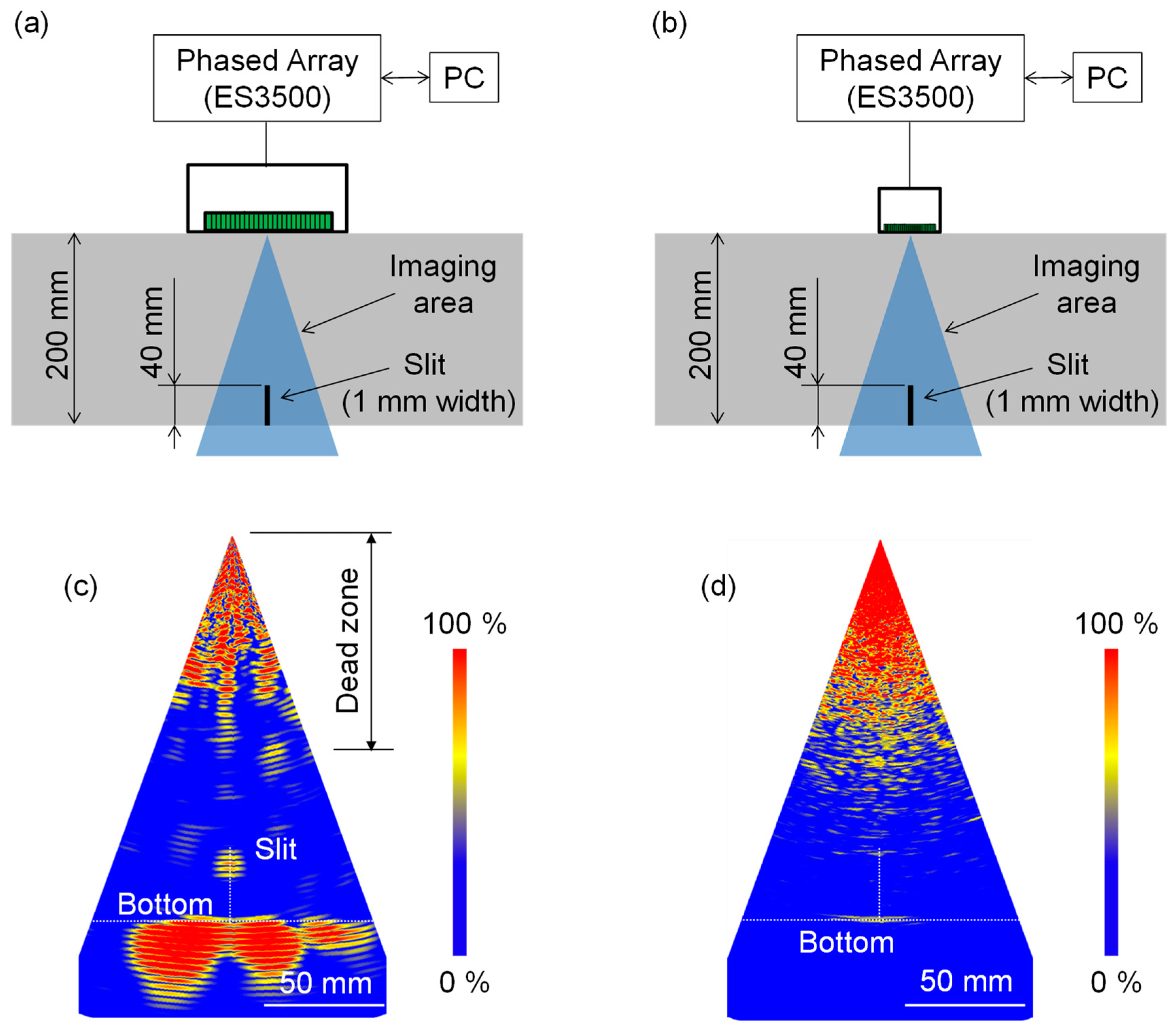
| Piezoelectric Material | ε33/ε0 | d33 (×10−12 m/V) | d31 (×10−12 m/V) | Qm |
|---|---|---|---|---|
| PT (M6) | 215 | 71 | −3.7 | 850 |
| Soft PZT (C9) | 6640 | 718 | −354 | 25 |
| Parameter | Value | Parameter | Value |
|---|---|---|---|
| Geometry Thickness (mm) Width (mm) | 4 8, 6, 4, 3, 2 | Density (kg/m3) | 7750 |
| Piezoelectric constants d33 (×10−12 m/V) d31 (×10−12 m/V) d15 (×10−12 m/V) | 718 −354 827 | ||
| Elastic constants C11 (GPa) C33 (GPa) C55 (GPa) | 65 64 26 |
Publisher’s Note: MDPI stays neutral with regard to jurisdictional claims in published maps and institutional affiliations. |
© 2021 by the authors. Licensee MDPI, Basel, Switzerland. This article is an open access article distributed under the terms and conditions of the Creative Commons Attribution (CC BY) license (https://creativecommons.org/licenses/by/4.0/).
Share and Cite
Ohara, Y.; Kikuchi, K.; Tsuji, T.; Mihara, T. Development of Low-Frequency Phased Array for Imaging Defects in Concrete Structures. Sensors 2021, 21, 7012. https://doi.org/10.3390/s21217012
Ohara Y, Kikuchi K, Tsuji T, Mihara T. Development of Low-Frequency Phased Array for Imaging Defects in Concrete Structures. Sensors. 2021; 21(21):7012. https://doi.org/10.3390/s21217012
Chicago/Turabian StyleOhara, Yoshikazu, Kosuke Kikuchi, Toshihiro Tsuji, and Tsuyoshi Mihara. 2021. "Development of Low-Frequency Phased Array for Imaging Defects in Concrete Structures" Sensors 21, no. 21: 7012. https://doi.org/10.3390/s21217012
APA StyleOhara, Y., Kikuchi, K., Tsuji, T., & Mihara, T. (2021). Development of Low-Frequency Phased Array for Imaging Defects in Concrete Structures. Sensors, 21(21), 7012. https://doi.org/10.3390/s21217012






